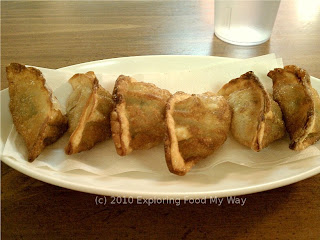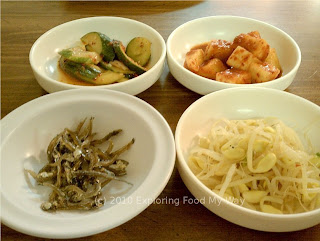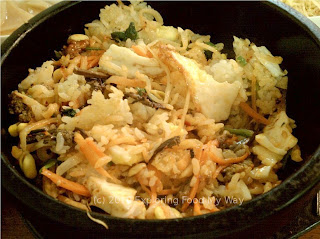On a random Saturday afternoon, I decided to stop in for lunch at around 12:30 PM. Seoul Garden shared the building with the Elks Lodge in Cuyahoga Falls and was quite close to the Ernest Angley's Cathedral of Tomorrow (which is a popular landmark for those in the Akron / Cuyahoga Falls area). Technically, the address was 2559 State Road, Cuyahoga Falls, OH 44223 and they can be reached at 330-929-9971. As of this writing, the restaurant did not have its own website. Parking was to the left of the building and the small lot in front of the restaurant.
Here was a shot of the front of the building, visible from State Road:

Once inside, my eyes adjusted to the darker environment and I sat myself at one of the empty tables. Two prominent facts sprung forth from my memory of my last visit. First, I was the only non-Korean person in the restaurant. Second, there seemed to be so few restaurant patrons. Today's visit was eerily similar. After I sat myself, an older gentleman running the front of the house stopped over to take my drink order and drop off a menu.
Here were photographs of the menu:




As I began to look over the menu, I began to realize why I had experienced such a difficult time ordering the last time I was in. Unlike other Korean restaurants at which I've eaten that have pictures either on the menu or on the wall, Seoul Garden's menu had zero illustrations. You had to completely rely on either the name of the dish itself or the English description provided. I often find that menu descriptions get lost in translation and try not to depend too much on them. The other problem I noticed today was a common one: different restaurants spell the same dish differently. For instant, the famous Korean stirred rice dish, Bibimbap, was spelled "Bi Bim Bob" on the printed menu and "Bi Bim Bab" on one of the few pictured dishes dimly illuminated on the wall.
Fortunately, this time around I recognized more than I didn't, but I can see why I had been so easily confused the first time I came to the restaurant as a Korean food neophyte. Seeing that there was a fried dumpling appetizer, I thought I would start out my meal by giving that a try. Shortly after ordering it, this arrived at my table:

Accompanying my fried dumplings was a soy sauce, rice vinegar, and chili dipping sauce with added scallions:

The first point I would like to make about the fried dumplings was their perfect fry job. I touched a dumpling with my finger and it came away clean and grease free. I tried the first dumpling sans dipping sauce and could taste the savoriness from the meat, the gentle heat from ginger and the pungency of garlic. This was a tasty dumpling. When my server stopped by to check on me, I asked him if the meat was pork. He informed me that they were, in fact, beef. Of course, I should've known that they were beef! I've had mandoo (aka mandu) at other Korean restaurants, but the dumplings were steamed and not deep fried.
After trying the dumpling naked, I then tried them dipped in the sauce. The sauce added just the right amount of seasoning, acidity, and spicy kick from the chili. The dumplings on their own were good. With the sauce, they were awesome. While I initially debated whether to eat all six dumplings in order to save room for the rest of my lunch, the minute I tasted them, I knew I would have zero willpower to resist the entire plate.
With most Korean meals I've been served, before the main course comes out, banchan are brought to the table. Every restaurant seems to serve different banchan, although kimchee seems to be a common denominator amongst them all. Soon after my appetizer plate was cleared, my banchan arrived at the table.
Here were the first four:

Clockwise from the top left you have pickled cucumbers, a chili spiced vegetable, bean sprouts and a salted, dried fish (sadly, the actual names of these particular banchan are unknown to me). The pickled cucumbers were the best among the lot and would appeal to most American palates. The chili spiced vegetable was interesting, a bit spicy and crunchy, but didn't have a very distinct vegetal flavor. The bean sprouts (which I think were soybean sprouts), had an earthiness to them and a unique flavor that other bean sprouts don't possess. The dried, salted fish were a flavor that may be popular with Koreans, but many Americans would have a problem with the assertiveness of the fishy flavor and crunchy texture.
Here was a shot of the other four dishes of banchan:

Again, clockwise from the top left you have a vinegared seaweed salad, what I thought was a pressed tofu dish, a sliced cooked potato in a slightly sweet dressing, and finally, that most famous of Korean dishes, kimchee. These were all quite nice, with Seoul Garden's kimchee having a more acidic tinge to it than I am normally used to. I liked this.
Within a few moments of my banchan arriving, the main event, the Dol Sot Bi Bim Bob (that was how it was spelled on their menu) arrived hot and sizzling:

Dolsot refers to the fact that the contents are served in a rocket hot stone bowl. The heat from the bowl helps to form a nice crusty layer on the rice sitting on the bottom of the bowl. Since bibimbap literally means "stirred rice," after adding a generous portion of chili sauce I used the spoon provided with my chopsticks to stir the contents of the bowl together, breaking the yolk and using the heat from the bowl to cook the sunnyside up egg. I was pleased that the egg came out with the yolk still runny. I didn't even have to make it a point to try and get the egg cooked that way; that was how it came out of the kitchen.
After stirring the contents of the bowl, this was what I ended up with as I put down the spoon and picked up my chopsticks:

To say that this was good was an understatement; this was great. Even after eating all of my appetizer and sampling from the various bowls of banchan, before I knew what had happened, I reached the bottom of the bowl. The creaminess from the egg worked beautifully with the crunchiness from the cooked rice. The salty and savory meat worked well with the plainness of the white rice. The snap and freshness from the vegetables really sang in my mouth. I don't know that this was the BEST version of bibimbap that I've ever had, but it was certainly among top five.
Oddly, in a twist that I've never come across before in a Korean restaurant, my lunch entrée was served with a bowl of totally clear soup:

Containing scallions, cabbage, and more of the bean sprouts, the broth was absolutely clear, a Korean consommé, if you will. While I didn't detect any scents from the ocean when I smelled it, I guessed that it was probably a beef consommé and a very light one, in terms of color and flavor, at that. While the soup came out at the same time as my entrée, I kept the soup until the end and used it more as a palate cleanser and aid in digestion.
With tax and tip, I ended up spending about $20 today for lunch at Seoul Garden. While this may seem expensive, it was completely in line with other Korean restaurants in northeast Ohio. There were some pretty pricey menu items on the rear of the menu, but many of those were dishes that were meant to be split amongst multiple people. While the flavors at Seoul Garden were quite good and even more important, quite authentic, I would have reservations recommending it to readers who aren't comfortable with either the language or the descriptions provided on the menu. My advice? Take someone along who IS comfortable and you will be rewarded with some really excellent food. I know that it will not be another seven years before I return again for another meal.


3 comments:
I have eaten here many times and find the beef bulgoki and banchan to be very good. I agree that ordering would be much easier if photos of the dishes were posted on the walls, a la Wonton Gourmet. Sometimes the name of the dish and resulting expectation don't quite match the dish when it arrives. And from a restaurant owner's point of view it could certainly increase revenues, because when you see a really fantastic plate of food it does make you want to order it and many others.
that was a great review. email me and we can eat there next time together. And I will share with you what all the food items are and go over their details. seungjinyi@gmail.com
The banchan that you thought might be pressed tofu is actually eomuk, or fish cake. It's assorted white fish that's been pureed with a few other ingredients and steamed. And the soup you received is typically what they serve traditionally with meals in Korea, unless they main dish is indeed a heartier soup or stew.
Post a Comment